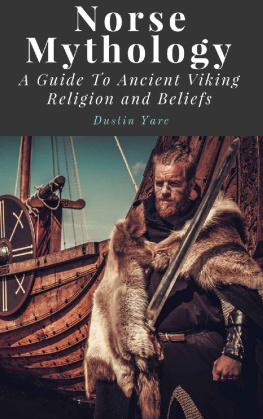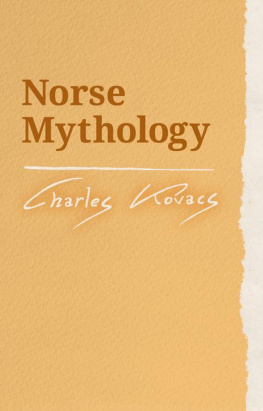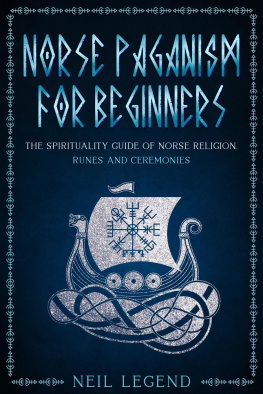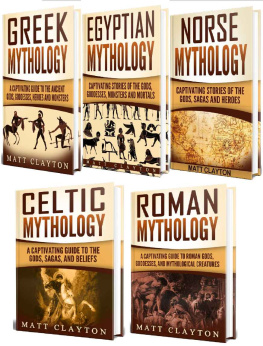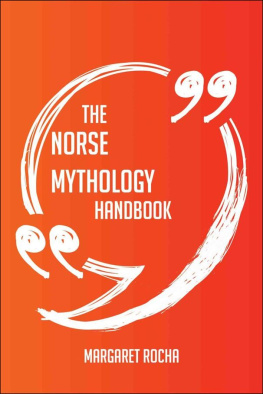Dustin Yarc - Norse Mythology: A Guide To Ancient Viking Religion and Beliefs
Here you can read online Dustin Yarc - Norse Mythology: A Guide To Ancient Viking Religion and Beliefs full text of the book (entire story) in english for free. Download pdf and epub, get meaning, cover and reviews about this ebook. year: 2017, genre: Religion. Description of the work, (preface) as well as reviews are available. Best literature library LitArk.com created for fans of good reading and offers a wide selection of genres:
Romance novel
Science fiction
Adventure
Detective
Science
History
Home and family
Prose
Art
Politics
Computer
Non-fiction
Religion
Business
Children
Humor
Choose a favorite category and find really read worthwhile books. Enjoy immersion in the world of imagination, feel the emotions of the characters or learn something new for yourself, make an fascinating discovery.
- Book:Norse Mythology: A Guide To Ancient Viking Religion and Beliefs
- Author:
- Genre:
- Year:2017
- Rating:5 / 5
- Favourites:Add to favourites
- Your mark:
- 100
- 1
- 2
- 3
- 4
- 5
Norse Mythology: A Guide To Ancient Viking Religion and Beliefs: summary, description and annotation
We offer to read an annotation, description, summary or preface (depends on what the author of the book "Norse Mythology: A Guide To Ancient Viking Religion and Beliefs" wrote himself). If you haven't found the necessary information about the book — write in the comments, we will try to find it.
Dustin Yarc: author's other books
Who wrote Norse Mythology: A Guide To Ancient Viking Religion and Beliefs? Find out the surname, the name of the author of the book and a list of all author's works by series.
Norse Mythology: A Guide To Ancient Viking Religion and Beliefs — read online for free the complete book (whole text) full work
Below is the text of the book, divided by pages. System saving the place of the last page read, allows you to conveniently read the book "Norse Mythology: A Guide To Ancient Viking Religion and Beliefs" online for free, without having to search again every time where you left off. Put a bookmark, and you can go to the page where you finished reading at any time.
Font size:
Interval:
Bookmark:
Norse Mythology
A Guide To Ancient Viking Religion and Beliefs
Dustin Yarc
Copyright 2017 by Dustin Yarc - All rights reserved.
The following eBook is reproduced below with the goal of providing information that is as accurate and as reliable as possible. The author does not claim to be an expert or scholar on the topics discussed within this work, and that any recommendations or suggestions made herein are for entertainment purposes only.
This declaration is deemed fair and valid by both the American Bar Association and the Committee of Publishers Association and is legally binding throughout the United States.
Furthermore, the transmission, duplication or reproduction of any of the following work, including precise information, will be considered an illegal act, irrespective whether it is done electronically or in print. The legality extends to creating a secondary or tertiary copy of the work or a recorded copy and is only allowed with express written consent of the Publisher. All additional rights are reserved.
The information in the following pages is broadly considered to be a truthful and accurate account of facts, and as such any inattention, use or misuse of the information in question by the reader will render any resulting actions solely under their purview. There are no scenarios in which the publisher or the original author of this work can be in any fashion deemed liable for any hardship or damages that may befall them after undertaking information described herein.
Additionally, the information found on the following pages is intended for informational purposes only. As befitting its nature, the information presented is without assurance regarding its continued validity or interim quality. Trademarks that mentioned are done without written consent and can in no way be considered an endorsement from the trademark holder.
Congratulations on downloading your personal copy of Norse Mythology. Thank you for doing so.
The following chapters will discuss many aspects of Norse mythology and the overall beliefs of the Vikings.
You will discover the two main clans of Gods and Goddesses: the Aesir and Vanir, as well as answers to questions such as:
- How did the Norse people view the cosmos?
- Who was their version of Adam and Eve in their own mythology?
- What are the runes, and what is their origin story?
- What did the Norse believe happened to a person after they died?
- As well as many other amazing thing from Norse history and mythology.
There are plenty of books on this subject on the market, thanks again for choosing this one! Every effort was made to ensure it is full of as much useful information as possible. Please enjoy!
The Aesir are one of two main clans of the Gods of the Norse pantheon. Aesir, pronounced ICE-ear, is the plural form of the word ss, which means "God." The Gods and Goddesses of the Aesir include many figures that are found in Scandinavian tales, including Tyr, Baldr, Thor, Frigg, and Odin. These Gods live in the realm of Asgard, which is separated from the mortal world of Midgard. The two places are connected by a rainbow bridge known as Bifrost. Asgard is one of the Nine Worlds and is found in the sunniest and highest branches of the world-tree Yggdrasil.
The Aesir belong to a very sophisticated group of cosmological, mythological, and religious belief systems. These views were shared by the Germanic and Scandinavian people. These traditions were first developed when significant culture and religions started to manifest, around 1000 BCE, until Christianity came to the area, which happened between 900 and 1200 CE.
Even though the beings that resided in Aesir were immortal, they were still thought to be more perishable than typical Indo-European immortals. The Aesir maintained their youth artificially from the golden apples of Ioun, and they could be killed as well.
The gods and goddesses of the Vanir and Aesir were viewed as contemporary figures that existed alongside each other, unlike in other polytheistic cultures where their Gods were seen as younger or elder compared to one another. These two main clans, the Vanir and Aesir, fought, exchanged hostages, and held treaties with each other. It is speculated that the difference between the Vanir and Aesir are reflective of the interactions that occurred between the different social classes of society during that time.
Odin is one of the main, and most complex, characters of Norse mythology. He is the head of the Aesir clan and had a tendency to venture from Asgard on solitary wanderings on self-interested quests. Odin was always looking to discover new things and loved sharing his wisdom. On the other hand, he had little regard for fairness, justice, common values, or for the respect of convention and law. He is the patron of outcasts and rulers, among other things.
Odin is also a war and poetry god and has qualities that are considered effeminate; conditions that would have brought shame to many ancient warriors. People that are looking for nobility, honor, and prestige would often worship him. He was also known to be a fickle trickster. Odin had quite an odd combination of characteristics, so how could one person house all of the qualities?
Odin can be translated to "Master of Ecstasy." When broken down into two parts, odr means "inspiration, fury, ecstasy," and inn is a masculine definite article which means "the master of." The ecstasy that Odin has is what brings together the many different areas that he is associated with: the dead, poetry, shamanism, magic, wisdom, sovereignty, and war.
In pop-culture depictions of him today, he is viewed as the battlefield commander and honorable ruler, but he was nothing like that to the Norse. In comparison to the truly noble gods of war like Thor or Tyr, Odin would incite peaceful people to meaningless strife with sinister glee.
Odin didn't like to worry himself with the average warrior, and he preferred to lavish his blessings on the ones that he specifically considered worthy of his attention. He kept close affiliation with other warrior-shamans whose fighting and spiritual practices were centered on creating an ecstatic unification with totem animals, typically bears or wolves, and then through extension, to Odin himself. This means that as a war-god, he wasn't concerned with the reasons as to why there was a conflict, or what the outcome would be, but instead, he simply loved the chaotic and raw frenzy of battle itself.
The main difference between monotheistic and polytheistic theologies is that, with the former, God is viewed as all-knowing, powerful, and loving. Polytheistic gods are limited, just like the people they watch over. Odin considered all types of limitations as something he had to overcome, thus causing his quests to be carried out in a cruel manner to grow his wisdom, knowledge, and power.
One of Odin's common characteristics is his single eye. The story goes that Odin sacrificed his other eye in order to gain great wisdom. One day, he ventured out to Mimirs Well. Mimir, a shadowy figure, lived there and his knowledge was considered unparalleled. Mimir achieved most of his knowledge by drinking the magical water from the well, so Odin had come to ask Mimir for some of the water. Mimir refused to share the water unless Odin was willing to sacrifice his eye. Odin, either after deliberation or straight away depending on the particular rendition of the story, gouged out an eye and then dropped the eye into the well. Mimir then dipped his horn in the well and gave Odin a drink.
On a separate occasion, Odin set out to discover the runes, which are symbols carved on the trunk of Yggdrasil by the Norns. This book will discuss more about the runes, the mythical tree Yggdrasil, and the Norns later on. Odin watched the Norns as they carved thes symbols into the tree, and envied them for their wisdom and powers. The runes reside in the Well of Urd, and they only show themselves to people who prove they are worthy, Odin decided to hang himself from Yggdrasil, stabbed himself with a spear, and looked down into the waters of the well below. He wouldn't allow any of the other gods to help him in any way, not even with offerings of water. Odin stayed in this position for nine days and nights. On the ninth night, he began to see shapes in the well: the runes.
Font size:
Interval:
Bookmark:
Similar books «Norse Mythology: A Guide To Ancient Viking Religion and Beliefs»
Look at similar books to Norse Mythology: A Guide To Ancient Viking Religion and Beliefs. We have selected literature similar in name and meaning in the hope of providing readers with more options to find new, interesting, not yet read works.
Discussion, reviews of the book Norse Mythology: A Guide To Ancient Viking Religion and Beliefs and just readers' own opinions. Leave your comments, write what you think about the work, its meaning or the main characters. Specify what exactly you liked and what you didn't like, and why you think so.

